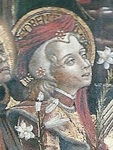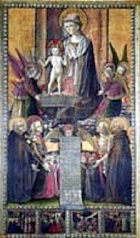


Detail of Gonfalone di San Fiorenzo (below)
An entry in the Roman Martyrology under 5th June records: “At Perugia, the holy martyrs Florentius, Julian, Cyriacus, Marcellinus, and Faustinus, who were beheaded in the persecution of Decius”.
There are two sources for the legend of St Florentius:
-
✴The legend summarised in the Roman Martyrology (BHL 3052) describes St Florentius as an accomplished orator and philosopher in Rome who acted as an advisor to the Emperor Decius (249-51), not least on the persecution of Christians. However, when he saw their stoicism in the face of martyrdom, he consulted his teacher Julian about the tenets of Christianity. These studies led both Florentius and Julian to convert, together with their friends Cyriacus, Marcellinus and Faustinus. They then gave all their possessions to the poor. Decius decided that they must be executed, but to avoid scandal in Rome he sent them to Perugia for execution, a sentence that was carried out on the 1st June. Their bodies were thrown into the Tiber but Decentius, Bishop of Perugia recovered them and buried them in a church that was dedicated to the Virgin.
-
✴An alternative legend can be derived from that of SS Felinus and Gratinian (BHL 3633), who were martyred in the reign of Decius at Perugia on 1st June. Their relics were apparently translated to Arone, near Milan in the 10th century (BHL 3634) and their legend (BHL 3633) was written there. It lists their companions in martyrdom, and these include Bishop Florentius of Perugia, who had encouraged their conversion to Christianity.
Note that neither legend explains the fact that the feast is celebrated on 5th June.
Pierluigi Licciardello (referenced below, at page 107) shows that both legends probably derived from:
-
✴the legend of SS Secundianus, Marcellianus and Veranus (BHL 7550-2), who were martyred near Civitavecchia on 9th August in the reign of Decius; and
-
✴the legend of SS Justin, Virianus and companions (BHL 4583), who were martyred at Perugia on 7/9th August or 1st June in the reign of Decius.
BHL 3633 gave rise in turn to the names of most of the so-called Martyrs of Saddi, the companions of St Crescentian of Città di Castello who were martyred on 1st June and buried at the Pieve di Saddi.
Cult of St Florentius
Local tradition identifies the church in which (in BHL 3052) St Florentius was buried as Santa Maria di Monterone, which was later rebuilt as the cemetery church of Santa Maria delle Grazie. This church was recorded in 1145 as dependent upon San Fiorenzo. At some point, the relics of St Florentius seem to have been translated from Santa Maria di Monterone to San Fiorenzo (presumably for greater safety). Both churches passed to the Cistercians in 1234.
In 1312, the civic statutes imposed the local celebration of the feast of St Florentius in an effort to revive his cult. In 1348, at the height of the Black Death, the Cistercians of San Fiorenzo found the headless body of St Florentius beneath the high altar paraded it through the city. St Florentius became an important plague saint in Perugia from this point: a similar procession was held, for example, during the plague of 1400.
In 1444, Pope Eugenius IV removed the Cistercians from San Fiorenzo and gave the complex to the Servite Observants. It seems that the cult of St Florentius as a plague saint had declined by this time, perhaps overtaken by the cults that had grown up around processional banners such as:
-
✴the Gonfalone di Santa Maria della Pace (1464), which the Commune had commissioned during the outbreak of plague and housed at San Francesco al Prato; and
-
✴the Gonfalone di Santa Maria Nuova (1471), which the Confraternita di San Benedetto commissioned for their altar in Santa Maria Nuova.
The Servites therefore commissioned the Gonfalone di San Fiorenzo (see below) during an outbreak of plague in 1476.
Bishop Cosimo de Torres, who took a particular interest in the affairs of the Servites of San Fiorenzo, designated St Florentius as a patron saint of Perugia in 1634.
The relics of St Florentius are preserved in a wooden casket (17th century) under the high altar of San Fiorenzo. One of its long sides has a painted image of the saint in military armour.
Gonfalone di San Fiorenzo (1476)

The banner depicts the Madonna with an extraordinary image of the naked baby Jesus standing in a basket of red roses with his arms outstretched, already carrying the marks of the Crucifixion. An angel below carries a scroll with a long poem that exhorts the citizens of Perugia to mend their evil ways. SS Sebastian and Florentius intercede for the city alongside two of the seven founders of the Servite order, both of whom were later canonised:
-
✴St Philip Benizi, who was Prior General of the Servites from 1267 until his death in 1285 and was the first Servite to be canonised (in 1671); and
-
✴St Peregrine Laziosi. As a young man, he slapped Philip Benizi during an affray in ca. 1290, and was converted when his victim turned the other cheek. He became a Servite and later cured himself of cancer of the foot by prayer. He died (from other causes) in 1345 and was canonised in 1726.
The predella shows scenes from the life of St Philip Benizi and and two posthumous miracles performed by St Peregrine Laziosi.
Read more:
E. Paoli, “Agiografia e Culto dei Santi a Perugia fra Alto e Basso Medioevo”, in
A. Bartoli Langeli and E Menestò (Eds), “La Chiesa di Perugia nel Primo Millennio: Atti del Convegno di Studi (Perugia, 1-3 April 2004)”, Spoleto (2005) pp. 41-84
Section 4 on St Florentius begins on page 47.
A. Czortek and P. Licciardello (Eds), “San Crescenziano di Città di Castello: Storia e Culto di un Martire dalle Origini all’ Età Modern”, Bollettino della Deputazione di Storia Patria per l' Umbria, 2 (2005) 5-252
See, in particular:
P. Licciardello, “Culto e Agiografia di San Crescenziano da Città di Castello a Urbino”, pp 91-168
Return to Saints of Perugia

